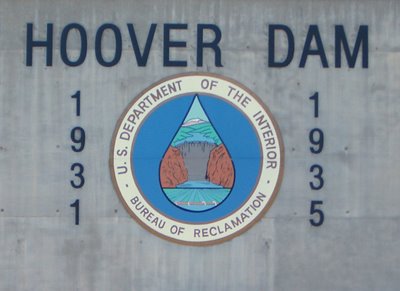
Lisette and I visited
Hoover Dam this afternoon. It is 30 miles southeast of Las Vegas in the Black Canyon and a perfect day-trip. We spent a little more than 2 hours there as we walked across the top of the dam and took the tour. The tour includes a short movie on the history of the dam, a descent 550 feet to the Nevada-side turbines and ascent back up to an observation deck. Hoover Dam is a must-see attraction and the tour is well worth its price ($10 for adults with this dollar off
coupon).
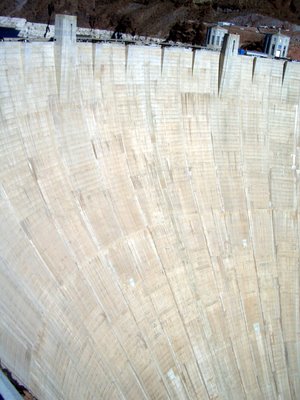
Hoover Dam truly is an awesome sight. It is 726.4 feet from foundation rock to the roadway on the crest of the dam, and it is 1,244 feet across at the top, 660 feet thick at the base and 45 feet thick at the top. It weighs more than 6,600,000 tons, and it contains 4,360,000 cubic yards of concrete in the dam and supporting structures. As our guide explained, that’s enough concrete to pave a standard highway 16 feet wide from San Francisco to New York City.
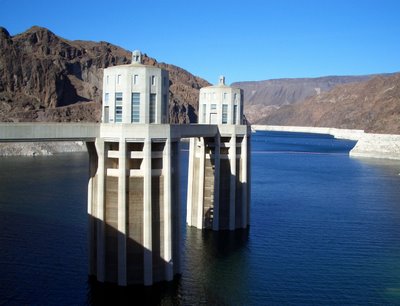
On the north side of the dam is Lake Mead. Lake Mead has a maximum depth 590 feet and is 115 miles across. Up to 9.2 trillion gallons of the Colorado River can be stored in Lake Mead, and it took six years to fill after the dam was constructed.
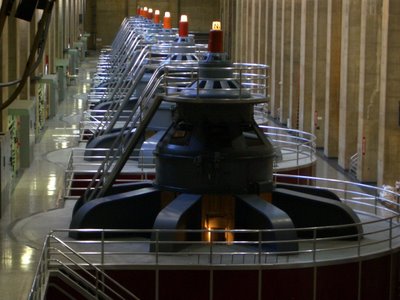
Two intake towers on the Nevada side and two intake towers on the Arizona side feed the 17 generators at Hoover Dam. Together these produce more than 2,000 megawatts of electricity. 56% of this power goes to California.
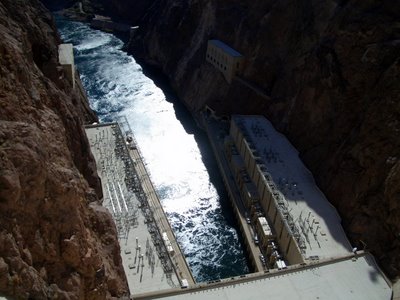
The first concrete for the dam was placed on June 6, 1933, and the last concrete was placed in the dam on May 29, 1935, 2 years ahead of schedule. The demand for concrete during construction of the dam was between 7,500 to 10,800 barrels a day. The concrete was cooled by embedding 582 miles of 1-inch steel pipe in the concrete and circulating cold water through it.
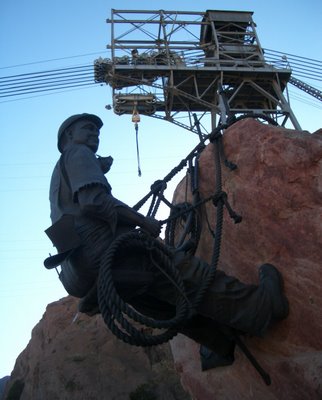
A total of 21,000 men worked on the Dam with an average of 3,500 daily. The men earned between $0.50 and $0.75 an hour and worked in 3 shifts, 24 hours a day, 7 days a week, 363 days a year.
 Lisette and I visited Hoover Dam this afternoon. It is 30 miles southeast of Las Vegas in the Black Canyon and a perfect day-trip. We spent a little more than 2 hours there as we walked across the top of the dam and took the tour. The tour includes a short movie on the history of the dam, a descent 550 feet to the Nevada-side turbines and ascent back up to an observation deck. Hoover Dam is a must-see attraction and the tour is well worth its price ($10 for adults with this dollar off coupon).
Lisette and I visited Hoover Dam this afternoon. It is 30 miles southeast of Las Vegas in the Black Canyon and a perfect day-trip. We spent a little more than 2 hours there as we walked across the top of the dam and took the tour. The tour includes a short movie on the history of the dam, a descent 550 feet to the Nevada-side turbines and ascent back up to an observation deck. Hoover Dam is a must-see attraction and the tour is well worth its price ($10 for adults with this dollar off coupon). Hoover Dam truly is an awesome sight. It is 726.4 feet from foundation rock to the roadway on the crest of the dam, and it is 1,244 feet across at the top, 660 feet thick at the base and 45 feet thick at the top. It weighs more than 6,600,000 tons, and it contains 4,360,000 cubic yards of concrete in the dam and supporting structures. As our guide explained, that’s enough concrete to pave a standard highway 16 feet wide from San Francisco to New York City.
Hoover Dam truly is an awesome sight. It is 726.4 feet from foundation rock to the roadway on the crest of the dam, and it is 1,244 feet across at the top, 660 feet thick at the base and 45 feet thick at the top. It weighs more than 6,600,000 tons, and it contains 4,360,000 cubic yards of concrete in the dam and supporting structures. As our guide explained, that’s enough concrete to pave a standard highway 16 feet wide from San Francisco to New York City. On the north side of the dam is Lake Mead. Lake Mead has a maximum depth 590 feet and is 115 miles across. Up to 9.2 trillion gallons of the Colorado River can be stored in Lake Mead, and it took six years to fill after the dam was constructed.
On the north side of the dam is Lake Mead. Lake Mead has a maximum depth 590 feet and is 115 miles across. Up to 9.2 trillion gallons of the Colorado River can be stored in Lake Mead, and it took six years to fill after the dam was constructed. Two intake towers on the Nevada side and two intake towers on the Arizona side feed the 17 generators at Hoover Dam. Together these produce more than 2,000 megawatts of electricity. 56% of this power goes to California.
Two intake towers on the Nevada side and two intake towers on the Arizona side feed the 17 generators at Hoover Dam. Together these produce more than 2,000 megawatts of electricity. 56% of this power goes to California. The first concrete for the dam was placed on June 6, 1933, and the last concrete was placed in the dam on May 29, 1935, 2 years ahead of schedule. The demand for concrete during construction of the dam was between 7,500 to 10,800 barrels a day. The concrete was cooled by embedding 582 miles of 1-inch steel pipe in the concrete and circulating cold water through it.
The first concrete for the dam was placed on June 6, 1933, and the last concrete was placed in the dam on May 29, 1935, 2 years ahead of schedule. The demand for concrete during construction of the dam was between 7,500 to 10,800 barrels a day. The concrete was cooled by embedding 582 miles of 1-inch steel pipe in the concrete and circulating cold water through it. A total of 21,000 men worked on the Dam with an average of 3,500 daily. The men earned between $0.50 and $0.75 an hour and worked in 3 shifts, 24 hours a day, 7 days a week, 363 days a year.
A total of 21,000 men worked on the Dam with an average of 3,500 daily. The men earned between $0.50 and $0.75 an hour and worked in 3 shifts, 24 hours a day, 7 days a week, 363 days a year.
0 Comments:
Post a Comment
<< Main page